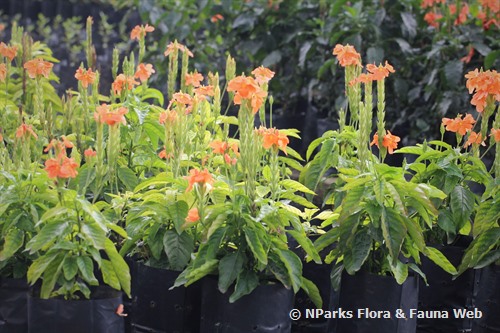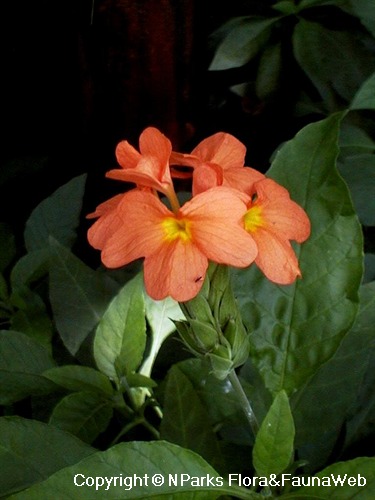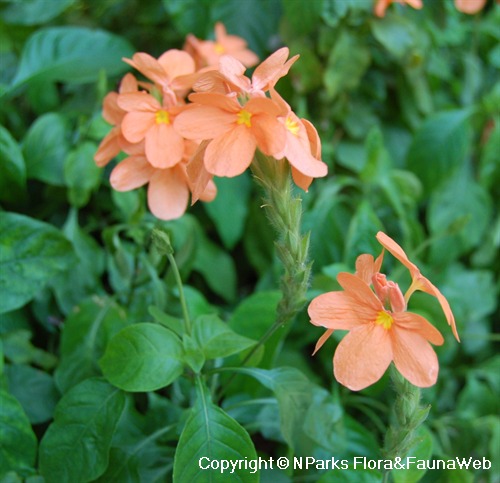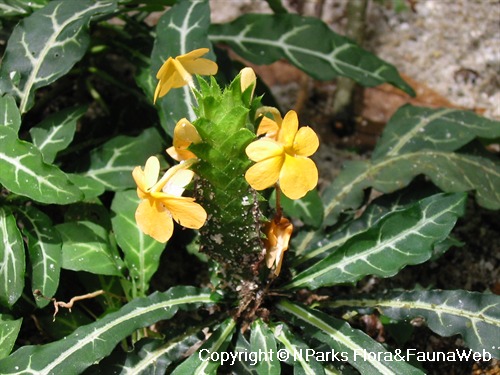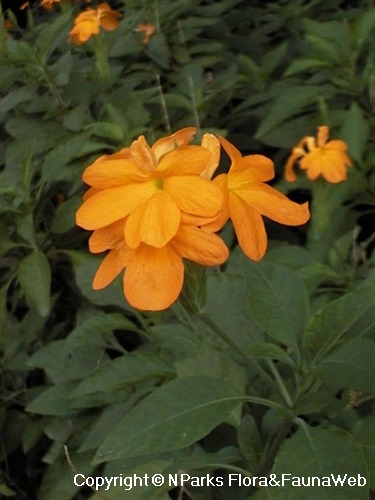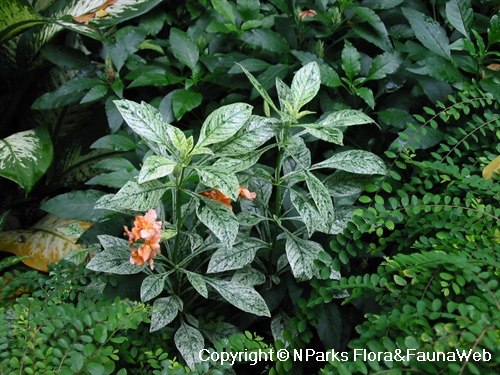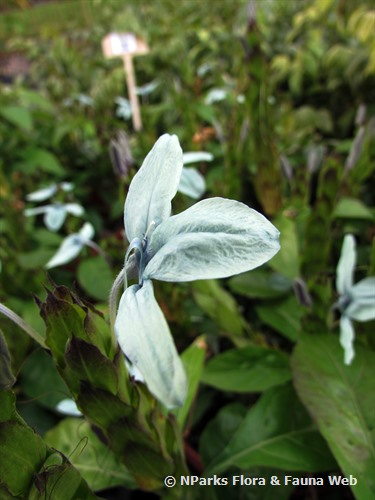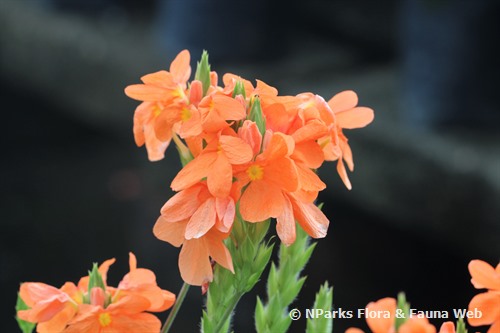
Back
Crossandra infundibuliformis (L.) Nees
| Family Name: | Acanthaceae |
| Synonyms: | Justicia infundibuliformis L., Crossandra undulaefolia Salisb. |
| Common Name: | Firecracker Flower, Firecracker Plant, Crossandra, 半边黄, 鸟尾花 |
Name
Classifications and Characteristics
| Plant Division | Angiosperms (Flowering Seed Plants) (Dicotyledon) |
|---|---|
| Plant Growth Form | Herbaceous Plant |
| Lifespan (in Singapore) | Perennial |
| Mode of Nutrition | Autotrophic |
| Plant Shape | Shrubby |
| Maximum Height | 0.3 m to 1 m |
| Maximum Plant Spread / Crown Width | 0.3 m to 0.6 m |
Biogeography
| Native Distribution | India, Africa, Sri Lanka, Thailand |
|---|---|
| Native Habitat | Terrestrial |
| Preferred Climate Zone | Tropical, Sub-Tropical / Monsoonal |
| Local Conservation Status | Non-native (Horticultural / Cultivated Only) |
Description and Ethnobotany
| Growth Form | It is an erect, evergreen, herbaceous plant up to 1 m tall. |
|---|---|
| Foliage | Leaves are oblong-ovate (3−12 cm long) with wavy leaf margin. Leaf arrangement is a false whorl of 4 leaves. |
| Flowers | Bright orange flowers have 5 unequal, overlapping lobes (2.5−4 cm wide, 1.5−2 cm long). The throat may be red or yellow. There are cultivars with orange-red, yellow-orange or red flowers. They are arranged in a dense terminal spike inflorescence with a 4-angled stem. Flowers emerge from green, leaf-like, overlapping bracts which are ovate to oblong. Flowering occurs throughout the year. |
| Fruit | Fruit is an oblong capsule (1 cm long), each containing 4 round seeds. It breaks open explosively, especially when touched. |
| Habitat | It occurs in the foothills at altitudes of up to 1300 m. |
| Cultivation | Plant in fertile soil enriched with organic matter and having good drainage. It is sensitive to overwatering and waterlogged sites. Allow the soil to dry before re-watering. Prune the plants to keep their height low, or the plants will develop a sprawling habit. Remove the brown seed pods and fertilize regularly to promote continuous flowering and healthy green leaves. It is susceptible to scale insects and spider mites. Indoor plants should be fed biweekly with a half-diluted general fertilizer. |
| Etymology | The genus name Crossandra is derived from 2 Greek words, "krossos" meaning fringe and "andros" meaning male. The reference is to the fringe of hairs on the male stamens in many species of this genus. The specific epithet infundibuliformis means trumpet-shaped, or funnel-shaped which refers to the flower shape. The common name "Firecracker Plant" refers to how mature capsules will explosively dehisce when touched with a moist finger. |
| Ethnobotanical Uses | Cultural / Religious: The plant is planted around temples for decoration. Others: In India and Sri Lanka, the flowers are combined with jasmine flowers to adorn women's hair. |
Landscaping Features
| Landscaping | This species makes a colourful ground cover, low hedge or bedding plant. The flowers will add bright colour to partially shady areas. Consider planting this species next to ferns, impatiens or caladiums. |
|---|---|
| Desirable Plant Features | Ornamental Flowers |
| Landscape Uses | Flowerbed / Border, Parks & Gardens, Small Gardens, Container Planting |
Fauna, Pollination and Dispersal
| Pollination Method(s) | Biotic (Fauna) |
|---|---|
| Seed or Spore Dispersal | Abiotic (Explosive Dehiscence) |
Plant Care and Propagation
| Light Preference | Semi-Shade, Full Sun |
|---|---|
| Water Preference | Moderate Water |
| Plant Growth Rate | Fast to Moderate |
| Rootzone Tolerance | Fertile Loamy Soils, Well-Drained Soils |
| Maintenance Requirements | Low |
| Diseases | Scale insects, spider mites |
| Pest(s) | Associated with, Sucking Insects |
| Propagation Method | Seed, Stem Cutting |
| Propagule Establishment Remarks | Rooting hormone should be applied to the stem cutting to promote rooting. |
Foliar
| Foliage Retention | Evergreen |
|---|---|
| Mature Foliage Colour(s) | Green |
| Mature Foliage Texture(s) | Smooth, Glossy / Shiny |
| Foliar Type | Simple / Unifoliate |
| Foliar Attachment to Stem | Sessile |
| Foliar Shape(s) | Non-Palm Foliage (Oblong, Ovate) |
| Foliar Venation | Pinnate / Net |
| Foliar Margin | Entire - Wavy / Undulate |
| Foliar Apex - Tip | Acute, Rounded |
| Foliar Base | Rounded / Obtuse |
| Typical Foliar Area | Mesophyll ( 45cm2 - 182.25 cm2 ), Microphyll ( 2.25cm2 - 20.25 cm2 ) |
| Leaf Area Index (LAI) for Green Plot Ratio | 4.5 (Shrub & Groundcover - Dicot) |
| Typical Foliar Size | 3 cm to 12 cm |
Floral (Angiosperm)
| Flower & Plant Sexuality | Bisexual Flowers |
| Flower Colour(s) | Orange |
|---|---|
| Flower Grouping | Cluster / Inflorescence |
| Flower Location | Terminal |
| Flower Symmetry | Radial |
| Individual Flower Shape | Salverform |
| Flowering Period | Free-Flowering |
| Flowering Habit | Polycarpic |
| Flower Size | 2 cm x 4 cm |
Fruit, Seed and Spore
| Mature Fruit Colour(s) | Brown |
|---|---|
| Fruit Classification | Simple Fruit |
| Fruit Type | Dehiscent Dry Fruit , Capsule |
Image Repository
Others
| Master ID | 589 |
|---|---|
| Species ID | 1884 |
| Flora Disclaimer | The information in this website has been compiled from reliable sources, such as reference works on medicinal plants. It is not a substitute for medical advice or treatment and NParks does not purport to provide any medical advice. Readers should always consult his/her physician before using or consuming a plant for medicinal purposes. |

